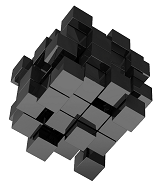 |

|
Content Owner: Herman Rutten | ||||
Summary
Hybrid/All-Flash: 0-3 Replicas (RAID1; 1N-4N)
All-Flash: Erasure Coding (RAID5-6)
All-Flash: Erasure Coding (RAID5-6)
Details
VMwares implementation of Erasure Coding only applies to All-Flash configurations and is similar to RAID-5 and RAID-6 protection. RAID-5 requires a minimum of 4 nodes (3+1) and protects against a single node failure; RAID-6 requires a minimum of 6 nodes and protects against two node failures. Erasure Coding is only available in vSAN Enterprise and Advanced editions, and is only configurable for All-flash configurations.
VMwares implementation of replicas is called NumberOfFailuresToTolerate (0, 1, 2 or 3). It applies to both disk and node failures. Optionally, nodes can be assigned to a logical grouping called Failure Domains. The use of 0 Replicas within a single site is only available when using Stretched Clustering, which is only available in the Enterprise editions.
Replicas: Before any write is acknowledged to the host, it is synchronously replicated on an adjacent node. All nodes in the cluster participate in replication. This means that with 2N one instance of data that is written is stored on one node and another instance of that data is stored on a different node in the cluster. For both instances this happens in a fully distributed manner, in other words, there is no dedicated partner node. When an entire node fails, VMs need to be restarted and data is read from the surviving instances on other nodes within the vSAN cluster instead. At the same time data re-replication of the associated replicas needs to occur in order to restore the desired NumberOfFailuresToTolerate.
Failure Domains: When using Failure Domains, one instance of the data is kept within the local Failure Domain and another instance of the data is kept within another Failure Domain. By applying Failure Domains, rack failure protection can be achieved as well as site failure protection in stretched configuration.
vSAN provides increased support for locator LEDs on vSAN disks. Gen-9 HPE controllers in pass-through mode support vSAN activation of locator LEDs. Blinking LEDs help to identify and isolate specific drives.
vSAN 6.7 introduces the Host Pinning storage policy that can be used for next-generation, shared-nothing applications. When using Host Pinning, vSAN maintains a single copy of the data and stores the data blocks local to the ESXi host running the VM. This policy is offered as a deployment choice for Big Data (Hadoop, Spark), NoSQL, and other such applications that maintain data redundancy at the application layer. vSAN Host Pinning has specific requirements and guidelines that require VMware validation to ensure proper deployment.
VMwares implementation of replicas is called NumberOfFailuresToTolerate (0, 1, 2 or 3). It applies to both disk and node failures. Optionally, nodes can be assigned to a logical grouping called Failure Domains. The use of 0 Replicas within a single site is only available when using Stretched Clustering, which is only available in the Enterprise editions.
Replicas: Before any write is acknowledged to the host, it is synchronously replicated on an adjacent node. All nodes in the cluster participate in replication. This means that with 2N one instance of data that is written is stored on one node and another instance of that data is stored on a different node in the cluster. For both instances this happens in a fully distributed manner, in other words, there is no dedicated partner node. When an entire node fails, VMs need to be restarted and data is read from the surviving instances on other nodes within the vSAN cluster instead. At the same time data re-replication of the associated replicas needs to occur in order to restore the desired NumberOfFailuresToTolerate.
Failure Domains: When using Failure Domains, one instance of the data is kept within the local Failure Domain and another instance of the data is kept within another Failure Domain. By applying Failure Domains, rack failure protection can be achieved as well as site failure protection in stretched configuration.
vSAN provides increased support for locator LEDs on vSAN disks. Gen-9 HPE controllers in pass-through mode support vSAN activation of locator LEDs. Blinking LEDs help to identify and isolate specific drives.
vSAN 6.7 introduces the Host Pinning storage policy that can be used for next-generation, shared-nothing applications. When using Host Pinning, vSAN maintains a single copy of the data and stores the data blocks local to the ESXi host running the VM. This policy is offered as a deployment choice for Big Data (Hadoop, Spark), NoSQL, and other such applications that maintain data redundancy at the application layer. vSAN Host Pinning has specific requirements and guidelines that require VMware validation to ensure proper deployment.
